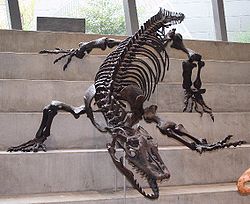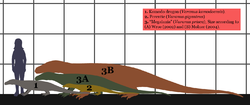- Megalania
-
Megalania
Temporal range: 0.04 Ma Late Pleistocene
Megalania skeletal reconstruction on Melbourne Museum steps Scientific classification Kingdom: Animalia Phylum: Chordata Class: Reptilia Order: Squamata Suborder: Scleroglossa Infraorder: Platynota Superfamily: Varanoidea Family: Varanidae Genus: Varanus Species: V. priscus Binomial name Varanus priscus
(Owen, 1859[1])Synonyms Megalania prisca Owen, 1859
Megalania ("great roamer"; Greek Μέγας "great" + ἀλαίνω "roam") is a giant extinct goanna or monitor lizard. It was part of a megafaunal assemblage that inhabited southern Australia during the Pleistocene, and appears to have disappeared around 40,000 years ago.[citation needed] The first aboriginal settlers of Australia may have encountered living Megalania.[2]
Contents
Taxonomy
Naming confusion
The name Megalania prisca was coined by Sir Richard Owen to mean "Ancient Great Roamer"; the name was intended to "reference to the terrestrial nature of the great Saurian".[1] Owen used a modification of the Greek word ἠλαίνω ēlainō ("I roam"). The close similarity to the Latin word: lania (feminine form of "butcher") has resulted in numerous taxonomic and popular descriptions of Megalania mistranslating the name as: Ancient Giant Butcher.
Megalania vs. Varanus
Megalania prisca was originally classified in its own monotypic genus. Its status as a valid genus remains controversial, with many authors preferring to consider it a junior synonym of Varanus,[3] which encompasses all living monitor lizards. As the gender of the genera Megalania and Varanus are different (feminine and masculine, respectively), the epithet prisca changes to priscus (in alignment with the Code of the ICZN).[4]
Phylogeny
Several studies have attempted to establish the phylogenetic position of Megalania within the Varanidae. An affinity with the Perentie, Australia's largest living lizard, has been suggested based on skull-roof morphology.[5] The most recent comprehensive study[6] proposes a sister-taxon relationship with the Komodo dragon based on neurocranial similarities, with the Lace monitor as the closest living Australian relative. Conversely, the Perentie is considered more closely related to the Gould's and Argus monitors.
Size
 Megalania skull, about 74 cm (29 in) long, at Museum of Science, Boston
Megalania skull, about 74 cm (29 in) long, at Museum of Science, Boston
The lack of complete, or nearly complete fossil skeletons has made it difficult to determine the exact dimensions of Megalania.[3] Early estimates placed the length of the largest individuals at 7 metres (23 ft), with a maximum weight of approximately 600–620 kilograms (1,300–1,400 lb).[7] However, more recent and more rigorous studies give very different results from one another.
In 2002, Stephen Wroe determined that Megalania had a maximum length of 4.5 metres (15 ft) and a weight of 331 kilograms (730 lb),[8] while its average length would have been around 3.5 metres (11 ft), and mean body weight would have been between 97–158 kilograms (210–350 lb).[8][9] He concluded[8] that the earlier estimates reaching lengths of 6 metres (20 ft) or more and a weight of several tons[10][11] were exaggerations based upon flawed methodologies.
However, Ralph Molnar[3] in 2004 determined a range of potential sizes for Megalania (made by scaling up from dorsal vertebrae, after he determined a relationship between dorsal vertebrae length and total body length). If it had a long thin tail like the Lace monitor (Varanus varius), then it would have reached a length of 7.9 metres (26 ft), while if its tail-to-body proportions were more similar to that of the Komodo dragon, then a length of around 7 metres (23 ft) is more likely. Taking the maximal 7 m length, he estimated a weight of 1,940 kilograms (4,300 lb), with a leaner 320 kilograms (710 lb) being average.[3]
Palaeobiology
Megalania is the largest terrestrial lizard known to have existed. Judging from its size, Megalania would have fed mostly upon medium to large sized animals, including any of the giant marsupials like Diprotodon along with other reptiles, small mammals, and birds and their eggs and chicks[citation needed]. It had heavily built limbs and body and a large skull complete with a small crest in between the eyes, and a jaw full of serrated blade-like teeth.[4]
Wroe et al. (1999)[12] regard the contention that Megalania was the only, or even principal, predator of the Australian Pleistocene megafauna with skepticism. They note that the "marsupial lion" (Thylacoleo carnifex) has been implicated with the butchery of very large Pleistocene mammals, while Megalania has not. In addition, they note that fossils of Megalania are extremely uncommon, in contrast to Thylacoleo carnifex with its wide distribution across Australian Pleistocene deposits.
The Australian biologist Tim Flannery suggested that if one wanted to reconstruct the ecosystems that existed before the arrival of the humans on Australia, it may be desirable to introduce Komodo dragons as a replacement for Megalania.[13]
Venom
Studies have shown that other members of the genus Varanus, such as the Komodo dragon and Lace monitor, possess venom glands along their jawline.[14] It has been suggested that other varanids, including Megalania, are likely to also have possessed similar glands.[15] If this were true it would make Megalania the largest venomous vertebrate known to have existed.
Claims of surviving remnants
While there are occasional reports from Australia and New Guinea of giant lizards similar to Megalania,[16] these reports only began after Megalania was first described and became publicly known,[3] and the possibility of a surviving population of the giant lizards is not accepted by mainstream scientists.[17][18]
References
- ^ a b Owen, R. 1859. Description of some remains of a gigantic land-lizard (Megalania prisca, Owen) from Australia. Philosophical Transactions of the Royal Society of London 149: 43-48.PDF available here
- ^ Megalania, giant ripper lizard, BBC - Science & Nature
- ^ a b c d e Molnar, R.E. 2004. Dragons in the Dust: The paleobiology of the giant monitor lizard Megalania. Indiana University Press.
- ^ a b Molnar, R.E. History of monitors and their kin. In: Pianka, E.R., King, D. and King, R.A. (Editors) 2004. Varanoid lizards of the world. Indiana University Press, 588 pp.
- ^ Lee MSY. 1996. Possible affinities between Varanus giganteus and Megalania prisca. Memoirs of the Queensland Museum 39: 232.
- ^ Head, JJ.; Barrett, PM.; Rayfield, EJ. 2009. Neurocranial osteology and systematic relationships of Varanus (Megalania) prisca Owen, 1859 (Squamata: Varanidae). Zoological Journal of the Linnean Society, 2009, 155, 445–457.
- ^ Hecht, M. 1975. The morphology and relationships of the largest known terrestrial lizard, Megalania prisca Owen, from the Pleistocene of Australia. Proceedings of the Royal Society of Victoria 87: 239–250.
- ^ a b c Wroe, S. 2002. A review of terrestrial mammalian and reptilian carnivore ecology in Australian fossil faunas, and factors influencing their diversity: the myth of reptilian domination and its broader ramifications. Australian Journal of Zoology 50: 1–24. PDF available here
- ^ Wroe S, Field J, Fullagar R, & Jermiin LS. 2004. Megafaunal extinction in the late Quaternary and the global overkill hypothesis. Alcheringa 28: 291-331.
- ^ Rich, T & Hall, B. 1984. In: Vertebrate Zoogeography and Evolution in Australasia (eds Archer, M. & Clayton, G.). Pg. 391-394.
- ^ Martin, P.S. & Kline, R.G. 1984. Quaternary Extinctions. University of Arizona Press, Tucson.
- ^ Wroe S, Myers TJ, Wells RT & Gillespie, A. 1999. Estimating the weight of the Pleistocene marsupial lion, Thylacoleo carnifex (Thylacoleonidae : Marsupialia): implications for the ecomorphology of a marsupial super-predator and hypotheses of impoverishment of Australian marsupial carnivore faunas. Australian Journal of Zoology 47: 489-498.
- ^ Flannery T. 1994. The Future Eaters, pp. 384-385. ISBN 0802139434
- ^ Fry, B. et al (February 2006). "Early evolution of the venom system in lizards and snakes" (PDF). Nature 439 (7076): 584–588. doi:10.1038/nature04328. PMID 16292255. http://www.nature.com/nature/journal/v439/n7076/abs/nature04328.html.
- ^ Komodo Dragons Kill With Venom, Researchers Find (National Geographic)
- ^ Australian Giant Reptilian Monsters - Queensland Reports
- ^ Cryptomundo.com » Megalania
- ^ Cryptozoology.com
External links
Varanoidea Kingdom: Animalia · Phylum: Chordata · Class: Reptilia · Order: Squamata Extant species Argus monitor · Black tree monitor · Bengal monitor · Black-spotted Ridge-tailed Monitor · Crocodile monitor · Desert Monitor · Dumeril's monitor · Emerald tree monitor · Gray's monitor · Kalabeck's monitor · Kimberley Rock Monitor · Komodo dragon · Lace monitor · Mangrove monitor · Mertens' Water Monitor · Nile monitor · Peacock monitor · Peach Throat Monitor · Perentie · Rock monitor · Pilbara monitor · Rennell Island Monitor · Rosenberg's Monitor · Short-tailed monitor · Spiny-tailed monitor · Timor tree monitor · Turquoise monitor · Sand goanna · Savannah monitor · Water monitor · Yellow MonitorRelated categoriesMonitor lizards · Cretaceous lizards · Helodermas · MosasaursFossil species DolichosauridaeHelodermatidaeVaranidaeMegalania · PalaeosaniwaCategories:- Pleistocene reptiles
- Pleistocene extinctions
- Prehistoric reptiles of Australia
- Monitor lizards
Wikimedia Foundation. 2010.


